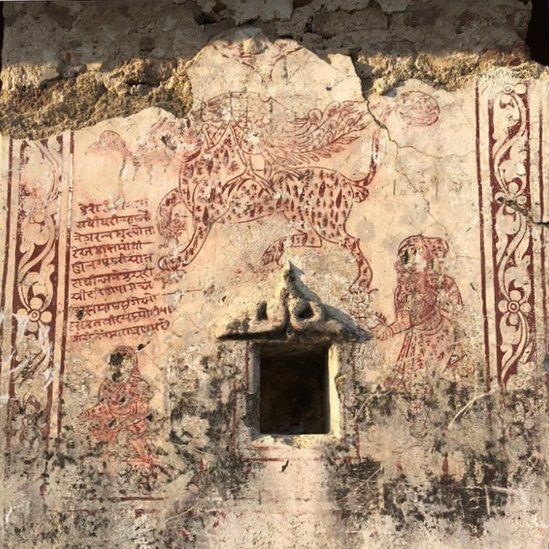Followers of Jainism in Pakistan: Ancient statues recovered from Nagar Parker in Sindh, shifted to Hyderabad for repair
 |
| GETTY IMAGES |
Nearly half a dozen Jain temples in the ancient city of Nangar Parkar in the desert region of Sindh are in a dilapidated condition, the restoration work of which is the responsibility of the Archaeological Department and Sindh Endowment Fund.
Nagar Parker has a run-off on one side and the Indian state of Gujarat on the other. Prior to partition, the people here had political, social, cultural and commercial ties with the Indian state of Gujarat.
But the transfer of the statues to Hyderabad has been objected to by academic and literary circles in Thar and a campaign has been launched on social media in this regard, demanding that the statues be kept in the Nagar Parker Museum.
Archaeological Department DG Manzoor Qanasro told the that the statues needed to be repaired and that there was no staff at Nagar Parker at the moment. "As soon as the staff is deployed there, the statues will be moved."
How the statues were recovered
Five idols were recovered during the restoration work of the ancient Jain temple in Nangarparkar city.
An expert involved in the restoration of the temple, linked to the Sindh Endowment Fund, said excavations during the restoration led to the discovery of the Garbhagra, an underground worship room, which was blocked with stones.
When they entered, they found a two-foot white marble statue of Mahavira, an incarnation of the Jain religion.
According to the expert, five more statues, made of golden sandstone and ten to two feet high, were found during excavations at the Gaushala near the temple. These also belong to Mahavira.
 |
| GETTY IMAGES |
"Will be back one day"
Experts say the temple in the city of Nangarhar was built in the 13th century. It was the Mahavira temple and was worshiped.
Remember that Mahavira or Mahavira is the twenty-fourth and last Tirthankar (chain of Gurus) of Jain Dharma, who was born in Bihar in the sixth century AD.
The Sindh Endowment Fund expert says that it seems that when the people of Jain Dharma migrated from here, they would have placed the idol of Mahavira in the underground worship room and closed the door because the temple This is the main statue.
They will think that it will be safe here and when the situation improves and they will be able to return to their original place.
Hindu deity in Jain Dharma temple
There are several Jain Dharma temples in and around Bhodesar, Viravah, in and around Nangarparkar, in which stone and marble work has been done. Stories have been told in some of them, but there are no idols in any of the temples.
The Gauri temple and the Nangarparkar city temple have images of Hindu deities, which make them look like Hindu Dharma temples.
An ancient temple is also located in the city of Vera Wah.
According to a Sindh Endowment Fund expert, the Jain temple is attributed to Shanti Natha, the sixth Tirthankar of Jain Dharma. He was born in a town near present-day Meerut.
According to the expert, the area was occupied by the Indian Army during the 1971 war and they took the statue with them, which is now in the Mumbai Museum.
Followers of Jainism in Pakistan
The five main principles of Jain Dharma are: non-violence, truthfulness, non-stealing, chastity and abstinence from the greed for wealth. Followers of this Dharma were considered environmentally friendly.
Allah Nawaz Khoso, a resident of Nagar Parkar, was among those who saw the Jains here. He died a few years ago.
He told the in an interview that Jenny cared for animals as well as humans. They took great care of cleanliness and ate before sunset.
They did not light lamps in their homes so that insects would not be burned to death and also provided food for animals and dogs.
According to Allah Nawaz Khoso, tensions between Pakistan and India forced Jenny people to leave their homeland. In the year Pakistan was formed, he left here with his idols. The rest of the families that were there also moved in 1971.
A stronghold of Jainism
Archaeologist Dr Kaleemullah Lashari, former secretary of the antiquities department, said that Nagar Parkar and Pari Nagar have been strongholds of Jains.
"From before the advent of Islam until the thirteenth century, the Jain community flourished in trade and when the community prospered, they built this temple."
"The present temples date back to the twelfth and thirteenth centuries."
There is a run-off area near Vera Wah, it is said that at one time the sea used to flow here and Pari Nagar was its port and the followers of Jainism used to trade by this sea route.
 |
| GETTY IMAGES |
According to Kaleemullah Lashari, with the change in the direction of the sea, business activities here became like this, after which they became dependent on the land route which was very difficult to pass. Therefore, it can be assumed that the traders had a problem.
In India, when a controversy arose over the construction of a Ram temple on the site of the Babri Masjid, the reaction was seen as far as Nagar Parkar and some people damaged the Jain temples.
Parts of these temples were also destroyed in the 2001 earthquake


Comments
Post a Comment
Please do not enter any spam link in the comment box.